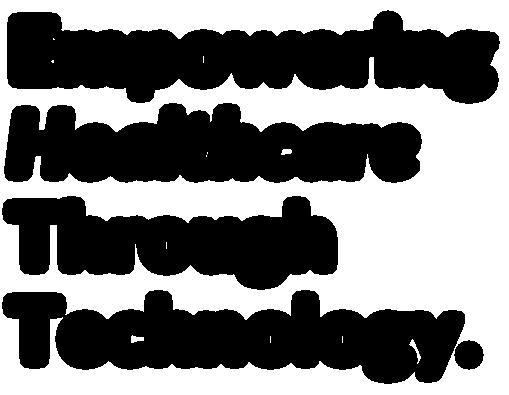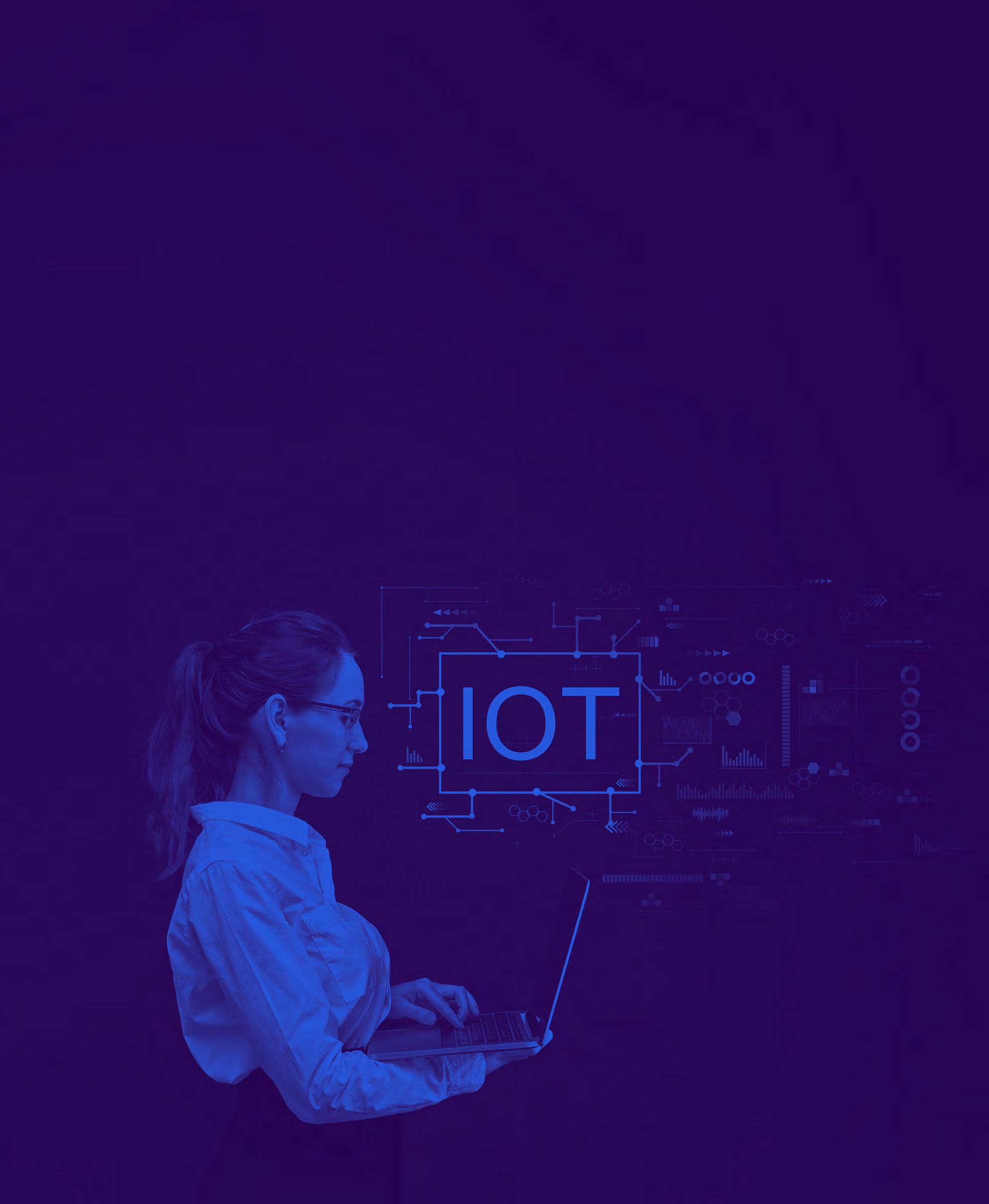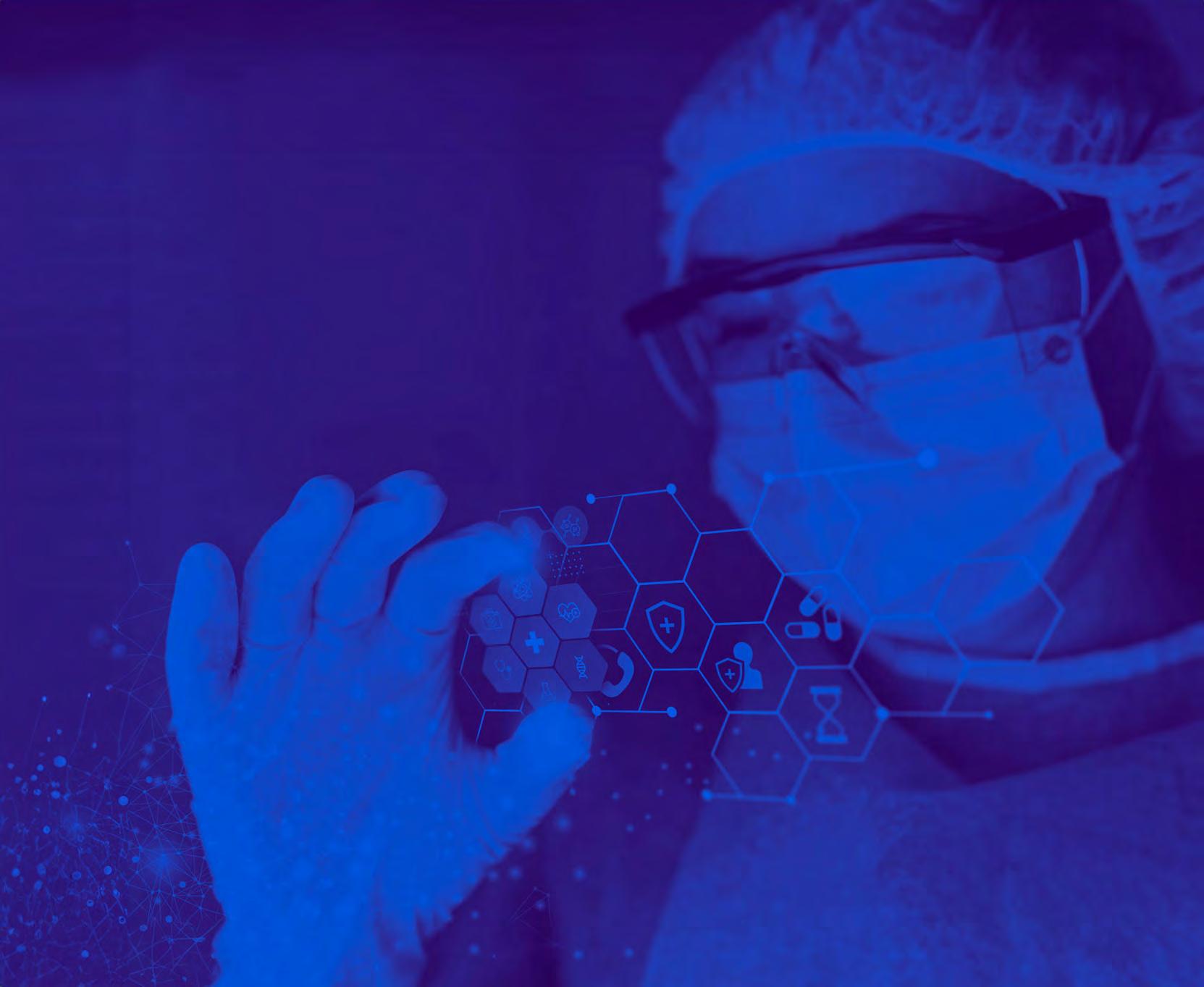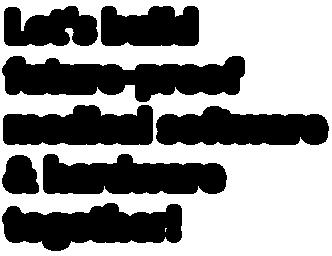Empowering Healthcare Through Technology.

The Path to Secure and Efficient Processes





Lately, the healthcare industry has witnessed remarkable transformations driven by technological progress. Many innovations improved patient care, diagnosis, treatment outcomes, and medical research.
The rapid growth of the Healthcare Information Software Market offers essential solutions for handling patient data, electronic health records (EHRs), and other vital documents. Custom software solutions streamline administrative processes while improving data accuracy and overall efficiency.
Healthcare organizations are showing an increased demand for cost-effective and scalable healthcare IT solutions focusing on increasing investments in this area. In addition to this, the healthcare landscape was reshaped by the Internet of Things (IoT), wearable devices, and real-time location systems, which ensure seamless communication and data integration. This trend is in complete harmony with the rise of mobile health application usage.
Relying on digital systems and interconnected networks has also raised concerns about cybersecurity in healthcare. Thus, robust cybersecurity measures and a secure infrastructure are imperative to safeguard patient data and ensure the integrity of healthcare systems.
These trends in healthcare technology are shaping a future where healthcare processes become more efficient and accurate, facing the current factors that are influencing global health evolution and, indeed, healthcare technology.
Alcohol Consumption
Tobacco Use
Physical Inactivity
Unhealthy Diet
Hypertension
Obesity
Ambient & Household Air Pollution
Cancer
Population Growth & Ageing
Epidemiological Transitions
*According to the World Health Statistics 2023 by WHO.1
will value $53.2 billion by 2029.
Given the rising prevalence of chronic diseases, lifestyle changes, and awareness of information systems efficacy inthemedicalindustry,theglobalhealthcareinformation software market is in plain expansion. Such systems enable precise diagnosis, treatment, and data exchange throughout various medical processes, including medical researchandclinicaltrials.
Specialists predict a growth2 of up to $53.2 billion by 2029, from $22.6 billion in 2021, more than double the increase in less than ten years for the healthcare information software market. One of the main factors fueling the industry’s expansion is the rise of chronic disorders due to accelerated population aging. Informationmanagementisessentialforfastandprecise diagnosisandtreatment.
Moreover, the market growth is also accelerated by global recent health risks, such as alcohol and tobacco consumption, obesity, hypertension, and climate change3,which make people prone to various diseases. Thus, healthcare professionals need to rely on fast data exchange systems not only to develop quick patient recovery programs but also to conduct research and avoiderrors.
The main end-users of such solutions are hospitals, diagnosticcenters,academicorganizations,andresearch institutes.
Healthcare organizations prioritize investments in software solutions to enhance infrastructure and processes.
Solutions like lab automation and clinical automation help streamline medical processes, improve patient care, enhance data analytics capabilities, and ultimately drive better healthcare outcomes. No wonder the global healthcare IT market size value is expected to have a 17.3%growthrateuntil2030.⁴
In the long-term, software solutions help optimize healthcare budgets, given the most recent technology trends. For example, expanding AI adoption can decrease costsbyupto10percentinhealthcareinstitutions.5
Investments in healthcare solutions are increasing, but compared to the last years, the focus is expanding from telehealth and general health solutions to even more specific areas.6 Investors are more oriented toward mental health, personalized patient experience, and back-officeinstruments.
Healthcare technology offers a better return on investment and improved healthcare results.
Smart hospitals are based on connected medical devices with sensors that collect real-time patient data, allowing continuousmonitoringandhealthissues detection. Healthcare professionals can implement a data-driven approach that offers improved diagnosis accuracy and optimizedtreatmentplans.Evenin2020,morethan80% of European clinicians used electronic health records (EHR, an essential tool in the emerging smart hospital market. With advanced connectivity and interoperability, smart hospitals are advancing and facilitating information exchange among healthcare professionals based on solutions that improve the medical workflow. The smart hospitals market keeps growing, and it is expected to reach$83billionin2026,from$35.9billionin2021.⁷
We can also observe the utility of smart hospital expansion in emergency care situations. IoT devices allow collecting data from multiple body parts8 with high accuracy quickly in moments when every second canbelifesaving.
People increasingly turn to mobile health (mHealth) applications to monitor their health status and well-being. These applications offer a wide range of functionalities, such as physical activity tracking and medication reminders, and they are even helpful in monitoring daily symptoms.
The global mHealth applications market is expected to have accelerated growth in the following tenyears. Even healthcare professionals believe such applications can be essentialinmonitoringandimprovingapatient’shealth.9
Some popular mHealth application categories are well-being, weight improvement, nutrition, sport & fitness activity, stress reduction, and relaxation.10 It is important to consider that applications do not replace butonlysupportspecializedmedicaladvice.
Pharmaceuticals and Life Sciences have become one of the most targeted industries for cybercrime, espionage, and sabotage.11 Damage might include, but is not limited to, lifesaving treatment data loss, patient data exploitation, decreasing reputation, and financialloss.
In 2022, US healthcare institutions were targets for an average of more than 1400 cyberattacks/per week, which is 86% more than in the previous year.12 Given such numbers, prevention has become more critical than detection. This is why healthcare organizations should implement and follow rigorous securitymeasures.
Specialists forecast a 15% year-over-year growth for the global healthcare cybersecurity market in the next five years.13 This is a good sign, showing that medical professionals are more likely to focus on security.
86% weekly cyberattacks increase in a year.
Technology transformed the medical and healthcare education field, allowing innovation to enhance learning experiences while improving patient care.
Studies have shown that after watching videos featuring patients discussing their hospital experiences, students reported higher OSCE (Objective Structured Clinical Examinations) scores and increased confidence when communicating with patients. Moreover, a study showed that 79% of learners considered a 13-minute video on fibromyalgia superior to traditional lectures delivered in person.14
Learning anatomy was also improved thanks to Artificial Intelligence (AI), which can store vast amounts of anatomical data for analysis. Virtual Reality (VR) and Augmented Reality (AR) allow immersive exploration of complex structures by using mobile devices and headsets. 15
The indispensable role of medical practitioners' expertise in anatomy cannot be overstated when it comes to patient examination, diagnosis, effective communication with patients as well as other physicians, and invasive procedures like surgery. Aspiring medical professionals should be excited about the advancements in cutting-edge technology, such as robotic surgical systems.16
These devices not only enhance precision during surgeries but also reduce potential risks associated with human error.
Learning platforms and medical devices allow students to gain early exposure to emergency room situations 17 and enhance their procedural skills, as an intermediary step before practicing in hospitals. In nursing education, clinical virtual simulation is proving itself a powerful instrument for improving knowledge retention, critical thinking, and psychomotor skill development. 18
The medical and healthcare education world has been truly transformed by technology, paving the way for innovative methods to enrich learning experiences while elevating the quality of patient care. By incorporating technology into academic curriculums, students can become medical professionals that can deliver exceptional patient care in a smart hospital environment.
With this exciting development, success is within reach for those willing to embrace novelty.


Success is within reach for those willing to embrace novelty.
INTEGRATED CLINICAL INFORMATION SYSTEMS
•Hospital Information Management System
•Laboratory, Radiology, Pharmacy, Pathology Information System
•Picture Archiving and Communication System
•Blood Bank Management System
ADVANCED TELEHEALTH SYSTEMS
•Online Patient Portals
•Remote Symptom Tracking & EMR Integration
•Virtual Specialist Consultation
•Medication Reminders
DATA MANAGEMENT SYSTEM
•Tracking Logs for Asset Monitoring
•Electronic Medical Records
•Patient Data Management
•Research Management System
LAB AUTOMATION
•Workflow scheduling
•Maintenance tasks automation
•Sample storage & management
•Automation of biomedical testing
•Automated liquid handling
INTELLIGENT BUILDING
•Power and Climate Management Systems
•Provision of Medical Gases
•Automated Door Locking System
•Network Infrastructure
INTERCONNECTED & PORTABLE MEDICAL DEVICES
•Mobile Devices for Health Monitoring
•Wearable Devices
•mplantable Medical Devices
•Stationary and Assistive Medical Devices
ACCESS CONTROL SYSTEMS
•Tags, Wristbands, Labels, and Badges
•Biometric Authentication
•User Management
•Internal Security & Surveillance System
*Based on the smart hospital assets.19
Smart hospitals are one of the most promising innovations in the healthcare industry. They are transforming patient care and medical services using cutting-edge technologies like artificial intelligence (AI), the Internet of Things (IoT), and data analytics. Statistics 20 show that, by 2030, the global smart hospitals market is expected to hit USD 164.88 billion.
The smart hospital infrastructure is complex and includes facilities that respond to different needs, from smart medical devices to lab automation. One of the most significant characteristics of smart hospitals is the interconnectivity between systems and devices that facilitate the improvement of processes and the introduction of new capabilities when it comes to patient care.
Below, we will analyze some of the most important components of smart hospitals and their role.
Smart hospitals integrate advanced technologies and systems to optimize different aspects of hospital operations. Intelligent facility management systems create a responsive, efficient, and patient-centric environment. Key functions include:
● Power and Climate Management Systems: these ensure a reliable and efficient energy supply while maintaining a comfortable environment for patients and medical staff. These systems typically include Energy Management Systems (EMS, Automated HVAC (Heating, Ventilation, and Air Conditioning), and Renewable Energy Integration.
●Provision of Medical Gases: smart hospitals use advanced solutions (Centralized Gas Supply and Management, Smart Gas Monitoring, Automated Gas Delivery) that ensure a safe supply of medical gases.
●Automated Door Locking System: security is paramount in healthcare facilities, and smart locking systems enhance patient safety and protect sensitive areas within the hospital.
At the core of these assets lies the Internet of Things (IoT), enabling seamless connectivity throughout the hospital ecosystem. At AROBS, we have a team with 10+ years of experience in developing intelligent IoT systems for international clients from several industries.
Learn more here .

Access control is very important in healthcare facilities, as it helps mitigate the risks associated with security breaches. Modern Access Control Systems ensure enhanced security and protect staff, patients, and data. Below are some of the main components of modern Access Control Systems:
●Tags, Wristbands, Labels, and Badges
●Biometric Authentication
●User Management Systems
●Internal Security & Surveillance System
The risks associated with the lack of access control systems include data breaches, theft of medical devices, handling of medical equipment by unqualified staff, and other types of malicious activities.
Interconnected and portable medical devices are essential components in smart hospitals, but they are also very useful for remote patient monitoring. These bring significant upgrades in patient care that are not typically common in traditional hospitals. Some of the most common devices include:
●Mobile Devices for Health Monitoring (e.g., glucose meters)
●Wearable Devices
●Implantable Medical Devices
●Stationary and Assistive Medical Devices (e.g. Infusion pumps)
Our team from AROBS Engineering has extensive experience in providing software and hardware solutions for medical devices. Some of their most significant projects include a new scalable hardware and software infrastructure that controls and monitors infusion pumps and an R&D project for cancer detection. As technology continues to evolve, medical devices become smarter and more automated, leading to better patient care, increased accuracy, and fewer errors.
Data management systems optimize healthcare operations, enhance patient care, and facilitate medical research. These systems create an interconnected network of information, enabling healthcare providers to make informed decisions and improve overall hospital efficiency. In this area, the most important functions include:

●Tracking Logs for Asset Monitoring
●Electronic Medical Records
●Patient Data Management
●Research Management Systems
By leveraging technology and data-driven insights, hospitals can optimize resource allocation, enhance patient care, and contribute to medical research. Our AROBS Life Sciences team has extensive experience in developing software products that simplify the clinical trial management system’s process for medicines, from research to approval, before reaching the consumer. Learn more here .
Integrated Clinical Information Systems (ICIS) are platforms that unify various clinical data and workflows. These systems bring together diverse information from different departments and medical devices, creating a holistic view of a patient's health status and medical history. This integration of data and processes enables healthcare professionals to make informed and timely decisions, leading to better patient outcomes. With the help of technology, smart hospitals can benefit from:
●Hospital Information Management Systems
●Laboratory, Radiology, Pharmacy, Pathology Information Systems
●Picture Archiving and Communication Systems
●Blood Bank Management Systems
Smart hospitals use Advanced Telehealth Systems to close the gap between patients and healthcare providers. These systems optimize healthcare processes and enhance accessibility to medical services by addressing challenges such as geographical barriers, patient engagement, and chronic disease management.
Here are some examples of solutions that are taking patient care to the next level:
●Online Patient Portals
●Remote Symptom Tracking & EMR Integration
●Virtual Specialist Consultation
●Medication Reminders
Clinical laboratories are no exception when it comes to technological advancements. Smart hospitals have modern laboratories where manual operations are automated, and the risk of human errors is highly diminished. The healthcare industry leaves no room for mistakes or delays, and labs that use technology to their advantage can significantly improve their operations. Here are some common solutions used by modern laboratories:
●Workflow scheduling
●Maintenance tasks automation
●Sample storage & management
●Automation of biomedical testing
●Automated liquid handling
As lab automation continues to evolve, its role in the healthcare field becomes even more critical, shaping the future of an era of precision and personalized care in smart hospitals. Our team from Berg Software is experienced in providing custom solutions for clinical laboratories using the latest technologies.
Learn more here .
For 12 consecutive years, healthcare data breaches have been the costliest among all industries. The average breach reached more than $10 mil. in 2022, which means a 41.6% increase in two years. 21 Such costs include financial losses, regulatory fines, legal fees, reputational damage, and potential lawsuits.
Organizations in the healthcare sector should be proactive rather than reactive when it comes to cybersecurity.22 Given the increasing reliance on healthcare technology, institutions must avoid leaving data vulnerable in front of cyberattacks.
A robust security model can be lifesaving in healthcare. For example, zero trust operates on the principle of "never trust, always verify". More specifically, access to resources and data is never assumed to be safe. 23 This approach emphasizes continuous identity checks and real-time monitoring of the healthcare organization’s security status.
HIPAA Journal highlights the importance of security – in May 2023 alone there was a concerning 330% increase in breached records. The main causes were hacking/IT incidents, unauthorized access, theft, and improper disposal. 24 These breaches highlight the urgent need for improved security measures.
It is important for healthcare organizations to implement basic and advanced security controls. It will ensure defense-in-depth, so that if one control fails, an alternative will take its place. You can find below the main security controls recommended by the Healthcare Information and Management Systems Society.25
• Anti-virus
• Backup and restoration of files/data
• Data loss prevention
• Email gateway
• Encryption at rest
• Encryption for archived files/data
• Encryption in transit
• Firewall
• Incident response plan
• Intrusion detection and prevention system
• Mobile device management
• Policies and procedures
• Secure disposal
• Security awareness training
• Vulnerability management program/patch management program

• Web gateway
• Anti-theft devices
• Business continuity and disaster recovery plan
• Digital forensics
• Multi-factor authentication
• Network segmentation
• Penetration testing
• Threat intelligence sharing (also called information sharing)
• Vulnerability scans
The global medical device size was valued at $512.29 billion in 2022 and is projected to reach $799.67 billion by 2030. The main market share of medical devices is represented by General Surgery, In-Vitro Diagnostics, Cardiovascular Devices, Orthopedic Devices, and Diagnostic Imaging. 26

Medical devices development comes with challenges. One of them is device certification and entering new markets, due to specific regional and national health regulations. Not only the hardware components must be certified, but also the software, including the collaboration applications used by developers.
AROBS Engineering ensures medical devices standards and certification requirements through Software Architecture Audit and Analysis, Compliance Guidance & Medical Standards (e.g., MDD, FDA 510(k), IEC 62304), and Test-driven Development. Find out more about their expertise here .
Regulatory compliance is crucial for obtaining market approval, ensuring the patients’ safety and information security. Let's examine some requirements around the world. It is worth knowing that besides these regional regulations, each country has specific norms that must be implemented.
The Food and Drug Administration (FDA) Regulation of Medical Devices27 plays a vital role in safety and efficacy in the United States healthcare system. FDA developed a risk-based classification system, that starts from low-risk (Class I) and goes up to high-risk (Class III). Requirements vary for each class, and the institution provides comprehensive regulatory guidance, including information on device classification, clinical trials, labeling requirements, and post-market surveillance.28 To obtain approval for medical devices and to maintain compliance throughout the lifecycle of the product, it is essential to follow the FDA regulations.
The Medical Device Regulation (MDR)29 has been implemented to enhance patient safety and improve the medical devices quality and reliability within the European Union. The MDR, includes a risk classification, registration pathways, and the CE marking regime. The regulation also includes provisions for unique device identification (UDI) and increased scrutiny of high-risk devices. Manufacturers must ensure compliance with the MDR by adhering to the defined timelines for transition, updating technical documentation, and conformity assessments.30
The Asia-Pacific region (APAC) comprises a diverse landscape of medical device regulations. It is important to understand the variations in terms of objectives, risk classification, and registration pathways before entering new markets.31 Manufacturers entering the APAC market should collaborate with local regulatory authorities and ensure compliance with country-specific regulations to commercialize medical devices successfully.
Streamlining Clinical Trials with Advanced Custom Software Solutions
•Handling patient screening and enrollment, trial phases, randomization, and drug supply management
•A software that streamlines clinical trial phases and drug development
•A web-based service with robust reporting capabilities
Java MS SQL CosmoDB Angular
.Net Core
Infrastructure Code (Terraform, Ansible)
Sharepoint Python Selenium
React FormIO Azure Cloud CI/CD Jenkins/Azure DevOps
•Decreased trial duration from a few years to less than a year
•The total cost of the process was reduced by up to 75%
•Reaching the best throughput of processed samples available on the market
•An adaptable and easy to maintain platform that could easily fit each lab’s requirements
•A system for hardware mapping that is adaptable for each type of equipment
•Performant workflows with the minimum necessary time for each sample, ensuring each step is efficiently done
•Lengthy and costly software updates for millions of medical devices that delivered point-of-care molecular testing for COVID-19, due to frequent virus mutation
•A solution that automatically updated medical devices, by deploying a microservices application to Azure Kubernetes Service
•Functionalities include collecting and analyzing medical data from clinical trials
Ansible
Python
Terraform
Jenkins
Azure Pipelines
SonarQube
Azure Artifacts
Azure DevOps
Git Azure Repos
Confluence
Jira
•Reduction of time and costs associated with manual labor
•Continuous device running and access to accurate clinical trials data
•Proper audit, deployment, and security prerogatives
•A costly and time-consuming process for verification and validation of point-of-care molecular testing for COVID-19, even for minor adjustments
•The lengthy validation process prevented having more than one release per year
•A V&V Automation tool for verification and validation processes
•Functionalities include a dynamic UI navigation, unit testing, low maintenance and update costs, scalability
REST API Python
Flask
Docker Raspberry Pi
•Significant time reduction compared to the manual V&V processes – from up to one year, to around one week
•Cost reduction, unattended automated processes, continuous device activity
We have seen that healthcare technology focuses on growing investments in cost-effective and scalable software, healthcare information systems, smart hospital development, mHealth applications, and rigorous cybersecurity standards. Innovation contributes to time-saving solutions, helping healthcare institutions optimize budgets and ensuring faster patient recovery and precise results.
A comprehensive study32 conducted with 22 experts showed that data-informed personalization based on smart hospitals and wearable devices will empower healthcare evolution in the short and medium term. In the medium and long run, climate change will have a significant impact, and sustainable solutions are an essential driver for innovation.
Highly skilled specialists embrace technological changes to create future-proof software solutions and devices for the medical industry. Their work will transform processes in your medical or healthcare organization.
The Life Sciences business line specialists of AROBS optimize clinical trial processes and health insurance. The AROBS team also has experience developing IoT systems for intelligent buildings and Cybersecurity expertise in various industries.
AROBS Engineering has accelerated the development of various medical devices. The most important projects include life-critical infusion pumps, robotic surgery, and cancer detection solutions.
Berg Software is specialized in projects for the Biomedical Software Engineering sector, specifically in Lab automation, Automated Liquid Handling, and Product Improvement.
1https://www.who.int/data/stories/world-health-statistics-2023-a-visual-summary/
2https://www.databridgemarketresearch.com/reports/global-healthcare-information-software-market
3https://www.who.int/publications/i/item/9789240074323
4https://www.grandviewresearch.com/industry-analysis/healthcare-it-market
5https://www.forbes.com/sites/joemckendrick/2023/02/22/healthcare-may-be-the-ultimate-proving-ground-for-artificial -intelligence/?sh=648f532b2b55
6https://www2.deloitte.com/xe/en/insights/industry/health-care/healthcare-technology-trends.html
7https://www.statista.com/statistics/1204318/smart-hospital-market-estimated-value-forecast/
8https://ieeexplore.ieee.org/abstract/document/10047997

9https://www.grandviewresearch.com/industry-analysis/mhealth-app-market
10https://www.researchgate.net/figure/Breakdown-of-most-popular-mHealth-app-categories_fig1_358088107
11https://www.pwc.com/gx/en/issues/cybersecurity/cyber-threat-intelligence/cyber-year-in-retrospect.html
12https://blog.checkpoint.com/2023/01/05/38-increase-in-2022-global-cyberattacks/
13https://cybersecurityventures.com/healthcare-industry-to-spend-125-billion-on-cybersecurity-from-2020-to-2025/
14https://bmcmededuc.biomedcentral.com/articles/10.1186/s12909-023-04218-z#ethics
15https://www.mdpi.com/1660-4601/19/21/14209
16https://www.uchealth.com/services/robotic-surgery/patient-information/benefits/
17https://journals.sagepub.com/doi/pdf/10.1177/20552076221143948
18https://www.ncbi.nlm.nih.gov/pmc/articles/PMC6447149/
19https://researchgate.net/figure/Smart-Hospital-Assets_fig2_310844589
20https://www.precedenceresearch.com/press-release/smart-hospitals-market
21https://www.ibm.com/downloads/cas/3R8N1DZJ
22https://www.forbes.com/sites/saibala/2023/04/29/with-increasing-reliance-on-healthcare-technology-cybersecurity-isa-growing-concern/?sh=71f76fbb26ee
23https://www.weforum.org/agenda/2023/05/cyber-attacks-on-healthcare-rise-zero-trust/
24https://www.hipaajournal.com/may-2023-healthcare-data-breach-report/
25https://www.himss.org/resources/cybersecurity-healthcare
26https://www.fortunebusinessinsights.com/industry-reports/medical-devices-market-100085
27https://crsreports.congress.gov/product/pdf/R/R47374
28https://www.fda.gov/medical-devices/device-advice-comprehensive-regulatory-assistance/overview-device-regulation
29https://eur-lex.europa.eu/legal-content/EN/TXT/?uri=CELEX%3A02017R0745-20230320
30https://www.medtecheurope.org/medical-devices-regulation-ce-marking-regime/
31https://apacmed.org/medical-device-regulation/
32https://www.sciencedirect.com/science/article/pii/S0016328723000010



